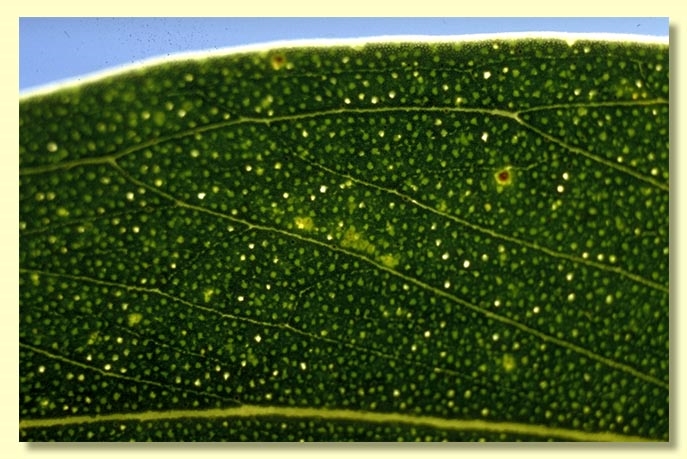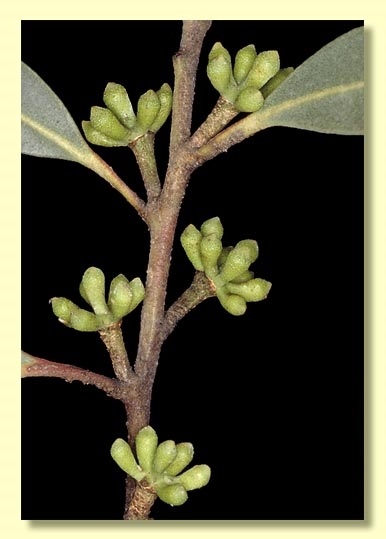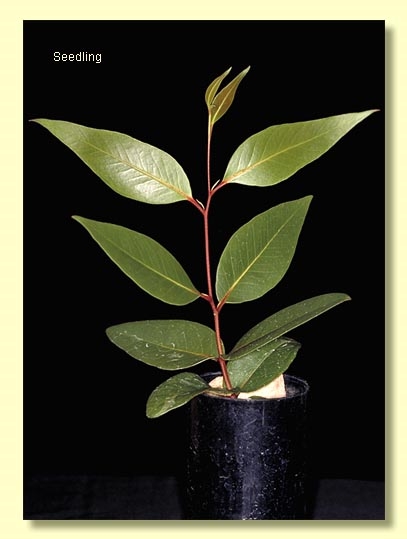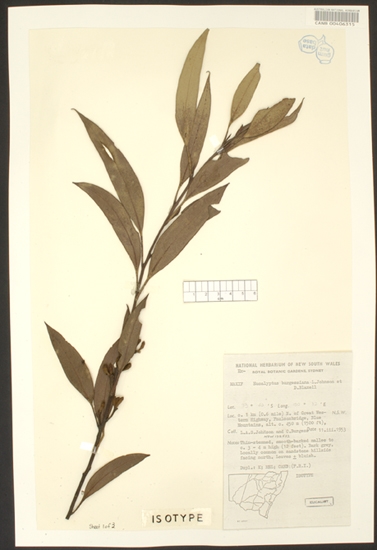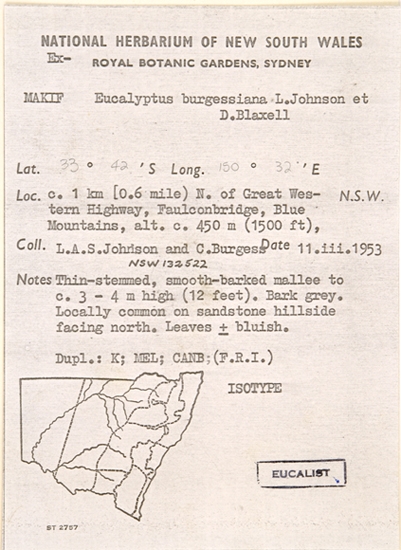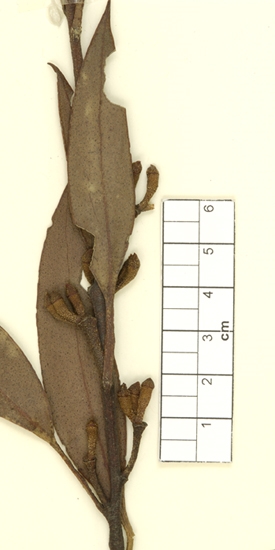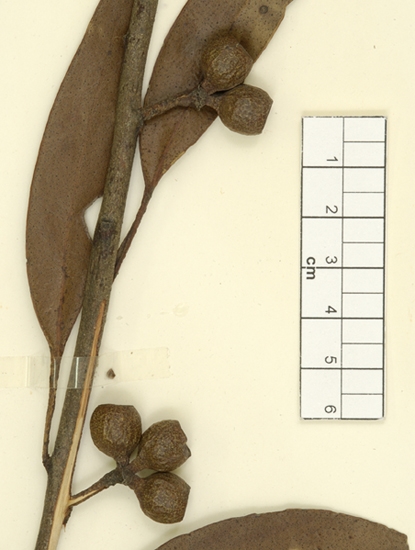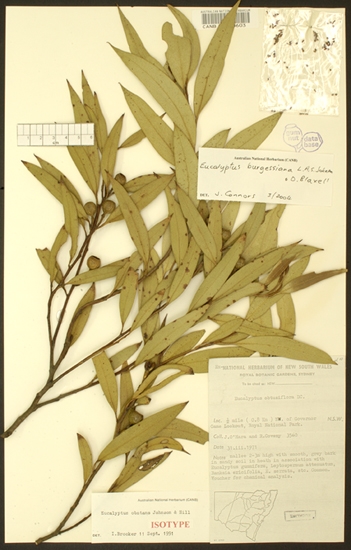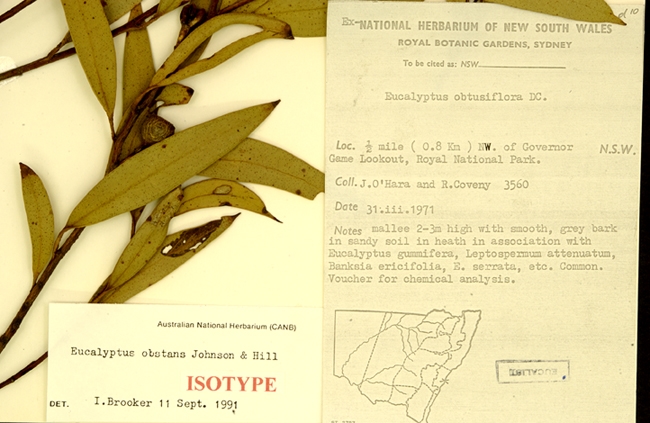Euclid - Online edition
Eucalyptus burgessiana
Eucalyptus | Eucalyptus | Eucalyptus | Strictae | Irregulares
Small tree or mallee to 7 m tall. Forming a lignotuber.
Bark smooth throughout, white, pink, orange, pale brown or grey.
Juvenile growth (coppice or field seedlings to 50 cm): stem rounded in cross-section, densely warty on lower stem (may feel scabrid); juvenile leaves alternate, broadly lanceolate, to 15 cm long, 5 cm wide, bases round or tapering to petiole,concolorous, glossy, bright green.
Adult leaves alternate, petiole 0.5–2 cm long; blade narrowly lanceolate to falcate, 7–13 cm long, 1.3–2.5 cm wide, base oblique or tapering to petiole, margin entire, concolorous, glossy or dull, green, side-veins very acute, reticulation absent, intramarginal vein parallel to and well removed from margin, oil glands island.
Inflorescence axillary unbranched, peduncles 0.8–1.9 cm long, buds 7, 9 or 11 per umbel, pedicels (0)0.2–0.6 cm long. Mature buds obovoid, 0.7–1.1 cm long, 0.3–0.6 cm wide, warty or smooth, with longitudinal ribs or ridges, scar absent, operculum conical to rounded-apiculate, stamens irregularly flexed, anthers reniform to cordate, versatile, dorsifixed, dehiscing by confluent slits, style long, stigma blunt or tapered, locules 3 or 4, the placentae each with 2 vertical ovule rows. Flowers white.
Fruit pedicellate (pedicels (0)0.2–0.6 cm long), barrel-shaped, cup-shaped, or slightly urceolate, (0.7)0.9–1.2 cm long, 0.7–1.3 cm wide, disc descending, valves 3 or 4, enclosed.
Seeds brown, 1.5–2.5 mm long, pyramidal or obliquely pyramidal, dorsal surface smooth, hilum terminal.
Cultivated seedlings (measured at ca node 10): cotyledons reniform; stems rounded in cross-section, scabrid to warty on lower internodes; leaves sessile, opposite, discolorous and elliptical for 3 to 5 nodes then becoming alternate, petiolate, ovate-lanceolate, 9–16 cm long, 3.5–5 cm wide, base rounded to tapering, apex finely pointed, becoming concolorous, glossy, green. Lower leaves scabrid along midrib on underside.
Flowering has been recorded in May, August, September, November and December.
A widespread mallee endemic to New South Wales, named originally from some natural plants remaining in the developed areas in the Blue Mountains west of Sydney, but relatively common elsewhere, extending to Jervis Bay.
E. burgessiana belongs to the green-leaved mallee ashes which are distinguished from the blue-leaved ashes by the glossy, green juvenile leaves and lack of glaucescence on all leaves, buds and fruits. These green-leaved mallee ashes form a series increasing in size of leaves, buds and fruits from the linear-leaved E. apiculata (leaves to 0.7 cm wide), to E. stricta (leaves to 1.6 cm wide), E. burgessiana (leaves to 2.5 cm wide), and E. langleyi, with leaves to 5 cm wide. The latter species is much coarser than the others and is notable for the strongly angled branchlets.
Eucalyptus burgessiana belongs in Eucalyptus subgenus Eucalyptus section Eucalyptus series Strictae, because of a combination of characters: mallee or small tree habit with smooth bark, alternate, green juvenile leaves, adult leaves held erect and with acute side-veins and little or no visible reticulation, single axillary inflorescences, the buds in clusters of sevens, rarely elevens, with buds having only one operculum and reniform anthers, ovules in two rows, and ± pyramidal seeds. Within series Strictae, E. burgessiana is one of six closely related species all with leaf oil glands that are irregular in outline (subseries Irregulares), the others being E. dendromorpha (a partly rough-barked tree with clavate buds in sevens), E. triflora (a small black-butted or entirely smooth-barked tree with oblong buds in threes or sevens), and E. apiculata, E. stricta and E. langleyi, which differ as described above.
E. obstans, based on the data presented by Hill & Johnson (1991), scarcely differs from E. burgessiana, overlapping almost completely in adult leaf, bud and fruit dimensions. We therefore place it in synonymy.



